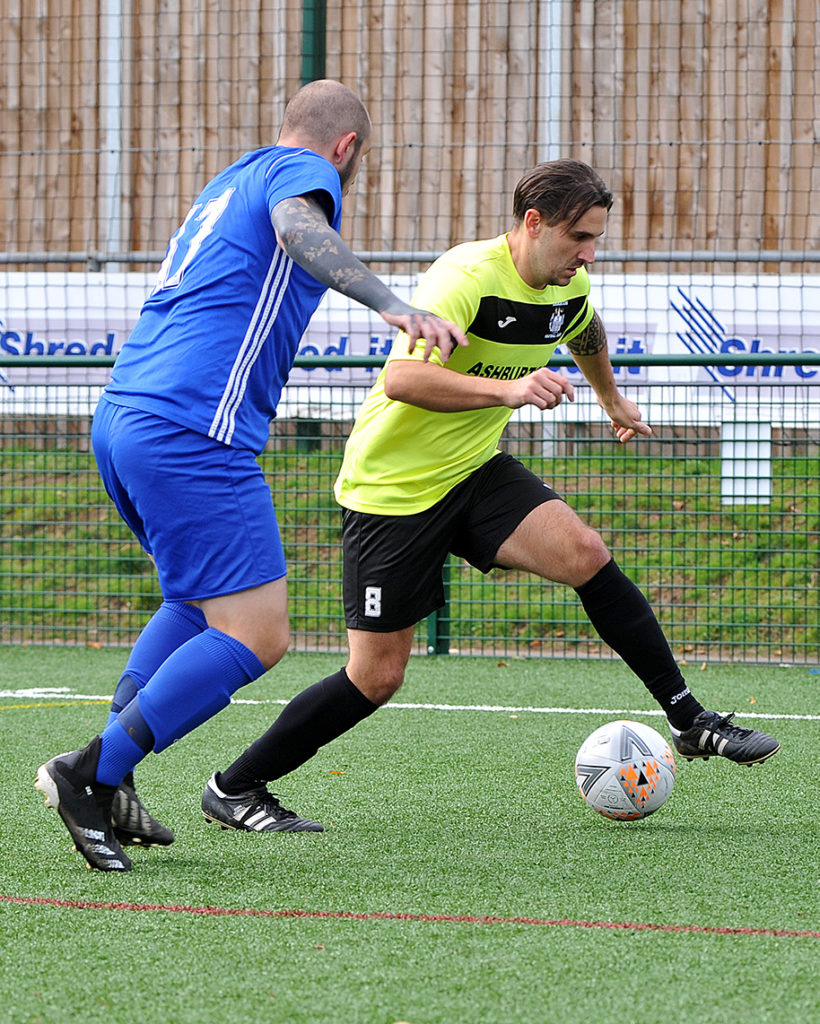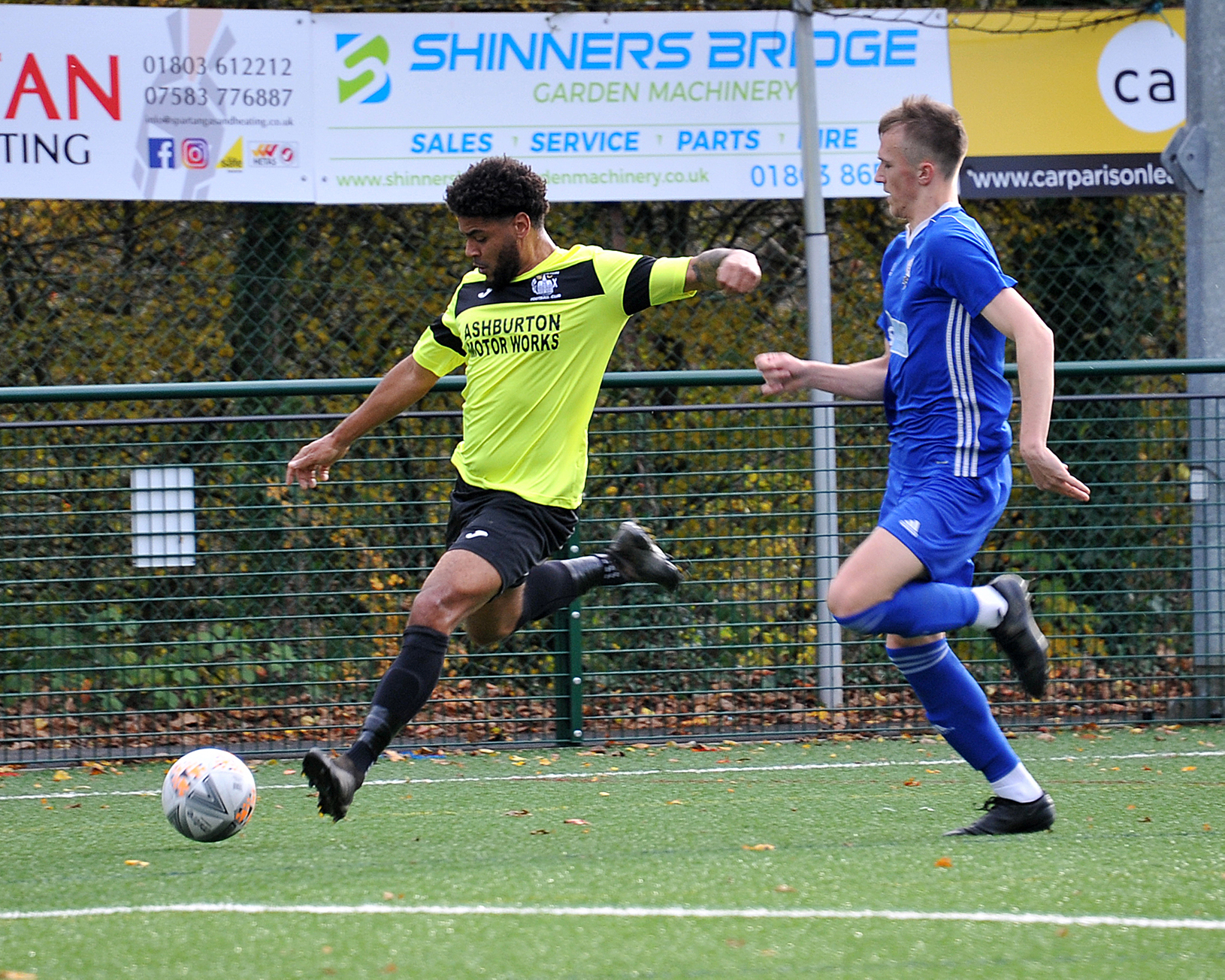South Devon Football League action from Coach Road. As a club photographer, make sure you contact the venue in advance for permission to take pictures. © Al Macphee/MiraclePR
Protecting your equipment – and yourself!
Let’s start with something that a new club photographer might not think about: keeping their equipment safe.
It’s not just a matter of being aware of where that ball is going to be in that shot (something we covered in How To Photograph Sports), it’s also a matter of where that ball is going to end up. We were at Coach Road taking pictures of a Herald Cup game between Paignton Saints and Ashburton and we were sat to the right of the goal. When the players were coming down the left, they were obviously going to either take a shot at goal or cross for someone else to take a shot. So that ball’s going to come our way.
You’ve got to be aware of where that ball might end up. If it smacks your lens, is that lens tough enough to cope with a ball travelling with the force of a thrown brick? Is that lens then going to smack you straight in the teeth? I got a cracking shot of the ball at Windmill Hill, Torquay but I moved too late and the ball hit the camera and the camera hit me so I ended up with blood on my face. I was at a cup final years ago and the ball came from the side and whacked me straight in the lens. The camera kept on going for the rest of the game but a couple of days later it packed up. It’s like it had knocked the mirror out. So is your gear tough enough to cope?
You’ve got to be aware of where that ball might end up. If it smacks your lens, is that lens tough enough to cope with a ball travelling with the force of a thrown brick?
You’ve got to make sure you are covered by insurance. Can you imagine being a fitness or dance instructor during the week, coming to a football match to take some pictures and somebody trips over your foot and breaks your ankle? You’re possibly off work for six weeks. Also, if somebody falls over you and gets injured they could sue you. Look at the big picture. If all you’re doing is being a club photographer, make sure you’re looking after your home and work life too. Because if you don’t, you could be up a creek without a paddle.
Handling controversial incidents as a club photographer
Be aware you could get caught up in controversial incidents.
I was the official photographer on a horse event, and one of the jump judges said that the horse hadn’t jumped between the flags. The rider’s mum was convinced that she had, so she wanted to see my pictures. This was right in front of the jump judges and other mothers. Had she been able to prove she was right, three other riders would have lost positions. Now, if I’m trying to sell photographs, upsetting three people to please one person is not a good idea.
If you’re supporting a club, rather than selling pictures, I don’t see anything wrong with using your images to back up your club, but you’ve got to be diplomatic about it. For example, never bring your pictures to the attention of the referee during a game. Referees and other officials shouldn’t change decisions based on evidence from spectators, but it does happen, and if one of your pictures is taken out of context, it could cause trouble. It’s what you get in the tabloids all the time.
Still pictures rarely produce good evidence. You would have to spend ages going through all the pictures to show them the whole series, and chances are you’re not going to have the whole series. Even with my kit, shooting at ten frames a second, you’re not guaranteed to get the whole series. You might not have that proof that he was going for the ball, so you’re just wasting a lot of time confusing the issue. Even if you do have a full series of still pictures of a controversial incident, it might not tell the whole story. A video with good sound would tell more of the story, because with a video you can tell what was said.
There was an issue at Torquay Women last weekend. There was a dodgy tackle on the field, which I caught, then somebody knocked somebody over, and then there was another dodgy tackle right in front of me, which was like a revenge attack. You could take the picture of the last tackle out of context and it’s a clear sending off. But if you were to connect the incidents together, yes, it’s a dodgy tackle but there was a reason for her doing it.
So, don’t get involved on the touchline. You shouldn’t even support your team on the touchline, because that can distract other players. I was once at a cup final as the official photographer, but a fellow photographer was also there but as a supporter. He was shouting, swearing and getting really involved in the game. The steward had to go and tell him to calm down, because it’s just not on. You have to appear neutral, even as a club photographer.
Don’t get involved on the touchline. You shouldn’t even support your team from the touchline. You have to appear neutral, even as a club photographer.
Following the rules

This leads on to a wider point about following the rules. For example, at some grounds you have to be so far back from the pitch.
Make sure you reach out to the home club before covering your team in an away game. That applies to neutral grounds too. Just because your team is in a cup final, you cant’t just rock up at the venue and automatically go on to the pitch. You have to get permission from the host venue.
If you’re attending a final at the likes of Coach Road, for example, they will usually have an arrangement with a photographer or a team of photographers to supply photographs to the press. You’re going to be stepping on loads of people’s toes and confusing the issue if you turn up and start sending your pictures to the local paper.
The organising committee is going to be asking the papers, ‘What’s going on here? You shouldn’t be using these pictures, because we wanted control over this.’
The official way to do it is to get permission from both clubs, permission from the venue, and if you’re working for a local paper, have a written confirmation that they’ve booked you to do that job.
Your club photographer agreement: get it in writing!
Your agreement with the club you are taking photographs for has to be in writing to protect everyone. This goes back to my first point. Even if the club says they’re going to cover you on their insurance, you need to see that written down. Verbal doesn’t cut it in a court of law.
If you have an accident and you need to pay your bills for six months, any insurance company will ask you to prove you’re covered. If they don’t have to pay out, they won’t. If you haven’t got that signature, formalise it. Diplomatically ask the chairman, or whoever is asking you to be the club photographer, ‘What happens if I’m involved in an accident? If I get hurt, who pays my bills?’ If they say, ‘Don’t worry, we’ll cover it on our insurance,’ say, ‘Can I have that in writing?’ And if they don’t want to do that then either walk away or stay on the other side of that barrier.
If the club says they’re going to cover you on their insurance, you need to see that written down. Verbal doesn’t cut it in a court of law.
If they want you to go on that pitch side, you’ve got to be insured, especially these days. With no win, no fee, people will sue at the drop of a hat today. If an opposing player falls over you and sues you, there’s your house gone. For the sake of taking a few pictures to support your local club? I don’t think so. You need to be covered.
Have a burning photography question you would like Al to write about in his next blog post? Email info@miraclepr.com with your request.

